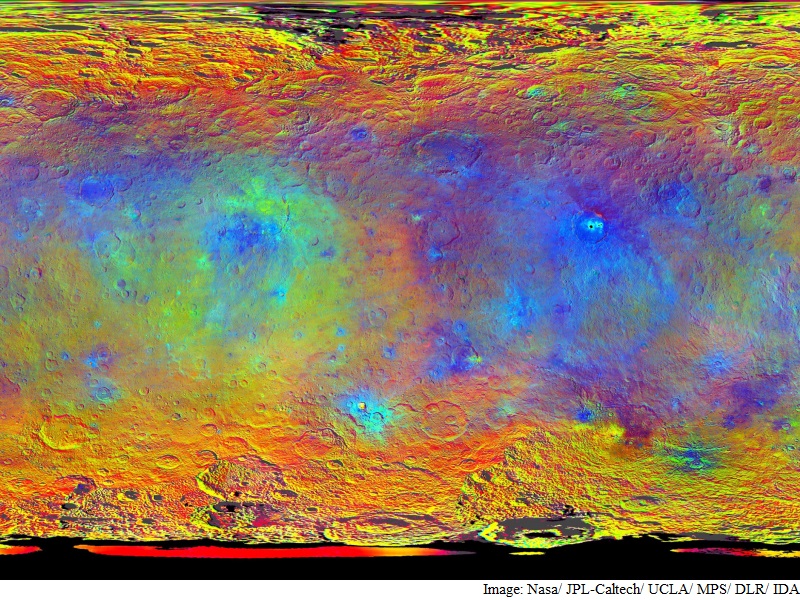- Home
- Science
- Science News
- Researchers Seek Public Help to Solve Mysteries of Dwarf Planet Ceres
Researchers Seek Public Help to Solve Mysteries of Dwarf Planet Ceres

Throwing open the doors to the hallowed halls of science, stumped researchers welcomed help from the public Wednesday in solving a number of nagging mysteries about dwarf planet Ceres.
Nasa's space probe Dawn, which travelled seven-and-a-half years and some 4.9 billion kilometres to reach Ceres in March this year, is the first to orbit a dwarf planet.
The probe is seeking to learn more about the structure of Ceres, which circles the Sun between Mars and Jupiter, in a bid to better understand the formation of Earth and other planets.
But many of the features of Ceres have left researchers scratching their heads including a six-kilometre (four-mile) high protrusion they have dubbed "Lonely Mountain".
"We're having difficulty understanding what made that mountain and we have been getting many suggestions from the public," Dawn's principal investigator Christopher Russell told reporters at a space conference in Nantes, western France.
One fan of the probe sent Russell an email saying the mountain reminded him of some ice structures he had seen in the woods years earlier while living in the US state of Arkansas.
"These ice structures started just poking out (of the ground). Each one of them had a rock or something like that protecting the surface, keeping it cool," Russell said in describing the ice.
"Maybe our lonely mountain was some sort of ice construct," the scientist said, adding: "We're taking suggestions like this very seriously."
Russell said "many suggestions" have poured in from the public but did not provide an exact number.
First classified a planet, then an asteroid, then a "dwarf planet" with some traits of a moon -- the more scientists learn about Ceres, the weirder it becomes.
"We have absolutely no idea what that... is due to," Russell said as he pointed to a blue ring on a map of the planet.
Later, of another unexplained attribute: "Again, I apologise, we haven't solved the source of this white material. We think that it's salt."
Scientists hope to learn more when Dawn moves in closer starting in October and into December as the spacecraft will descend to its lowest and final orbit at an altitude 375 kilometres.
The probe will continue capturing images of Ceres and collecting higher-resolution data.
It is due to stay in operation to mid-2016.
Get your daily dose of tech news, reviews, and insights, in under 80 characters on Gadgets 360 Turbo. Connect with fellow tech lovers on our Forum. Follow us on X, Facebook, WhatsApp, Threads and Google News for instant updates. Catch all the action on our YouTube channel.
Related Stories
- Samsung Galaxy Unpacked 2025
- ChatGPT
- Redmi Note 14 Pro+
- iPhone 16
- Apple Vision Pro
- Oneplus 12
- OnePlus Nord CE 3 Lite 5G
- iPhone 13
- Xiaomi 14 Pro
- Oppo Find N3
- Tecno Spark Go (2023)
- Realme V30
- Best Phones Under 25000
- Samsung Galaxy S24 Series
- Cryptocurrency
- iQoo 12
- Samsung Galaxy S24 Ultra
- Giottus
- Samsung Galaxy Z Flip 5
- Apple 'Scary Fast'
- Housefull 5
- GoPro Hero 12 Black Review
- Invincible Season 2
- JioGlass
- HD Ready TV
- Laptop Under 50000
- Smartwatch Under 10000
- Latest Mobile Phones
- Compare Phones
- Redmi Note 15 5G
- Redmi Note 15 Pro 5G
- Redmi Note 15 Pro+ 5G
- Lava Play Max
- Poco C85 5G
- Honor Magic 8 Lite
- Jolla Phone
- Realme P4x 5G
- Asus ProArt P16
- MacBook Pro 14-inch (M5, 2025)
- OnePlus Pad Go 2
- Poco Pad M1
- Just Corseca Skywatch Pro
- Honor Watch X5
- Acerpure Nitro Z Series 100-inch QLED TV
- Samsung 43 Inch LED Ultra HD (4K) Smart TV (UA43UE81AFULXL)
- Asus ROG Ally
- Nintendo Switch Lite
- Haier 1.6 Ton 5 Star Inverter Split AC (HSU19G-MZAID5BN-INV)
- Haier 1.6 Ton 5 Star Inverter Split AC (HSU19G-MZAIM5BN-INV)
















